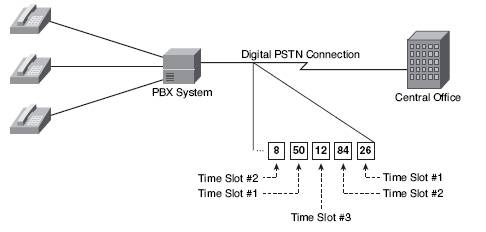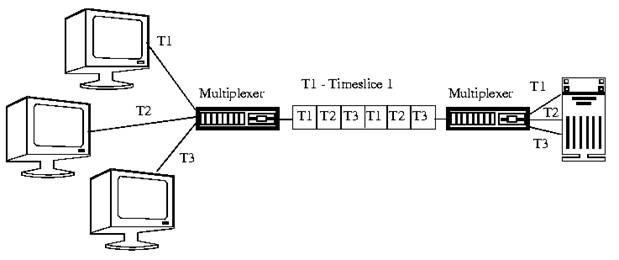Analog transmissions have two major drawbacks – the degradation of signal over long distances and secondly multiple calls cannot be sent over a single line.
Digitalization of voice solves the problem of signal degradation over long distances. To address the second issue we can use multiplexing in digital and analog voice networks.
Time division based multiplexing can be used in voice networks to carry multiple conversations simultaneously over a single four wire path. Since multiple conversations are digitized the numeric values can be transmitted in specific time slots (so the time division), to separate conversations. Figure 1 illustrates how time division multiplexing works.
Figure 1: Time division multiplexing of voice channels

Each voice conversation is digitized and assigned a numeric value for transmission over the digital PSTN line. Based on the time slot in which data is sent, the voice conversation is reassembled at the other end.
Digital voice connections to PSTN as T1 circuits are commonly used in US, Canada and Japan. T1 signal have 64 Kbps 24 separate channels (DS0) as called and E1 circuits commonly used in Europe and Mexico have 30 DS0s for voice calls.
Statistical multiplexing is similar to dynamic bandwidth sharing. In this type of multiplexing a communication channel is divided into an arbitrary number of variable bit-rate digital channels or data streams. The link sharing is adapted to the instantaneous traffic demands of the data streams that are transferred over each channel. Statistical multiplexing allows the bandwidth to be divided arbitrarily among a variable number of channels (while the number of channels and the channel data rate are fixed in time division multiplexing. Statistical multiplexing ensures that slots will not be wasted (unlike TDM where slots can be wasted). The transmission capacity of the link will be shared by only those users who have packets. Figure 2 illustrates how statistical multiplexing works.
Figure 2: Statistical multiplexing of voice channels

Statistical Multiplexing makes use of intelligent devices that are capable of identifying when a terminal is idle. They allocate time only to lines when required. This means that more lines can be connected to a transmission medium because this device statistically compensates for normal idle time (in data communication lines). Statistical multiplexing device units also provide some additional features and functionalities such as: data compression, line priority, mixed speed lines, host port sharing, network port control and automatic speed detection.
This concludes the CCNA Voice lesson covering multiplexing techniques; time division multiplexing and statistical multiplexing.
